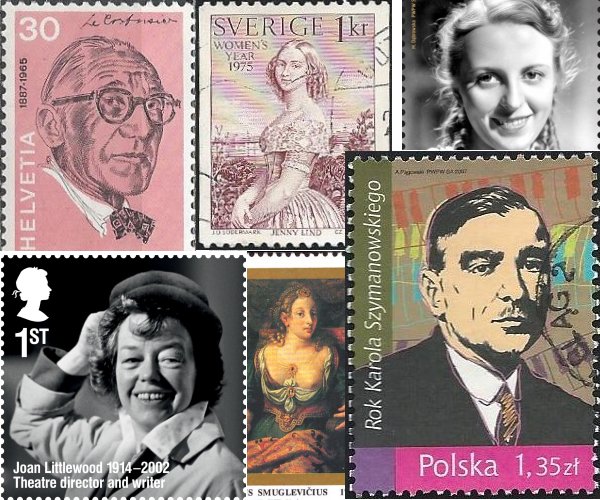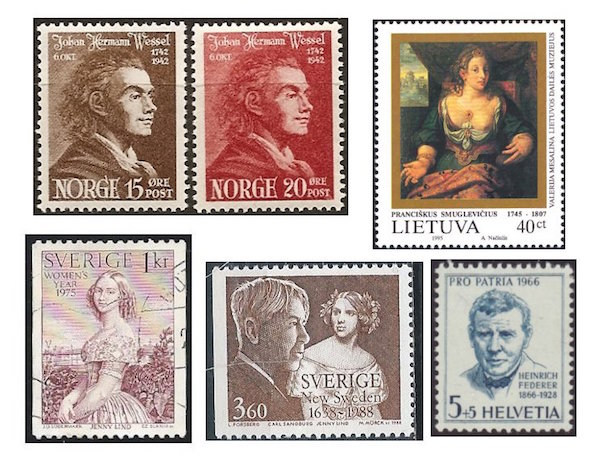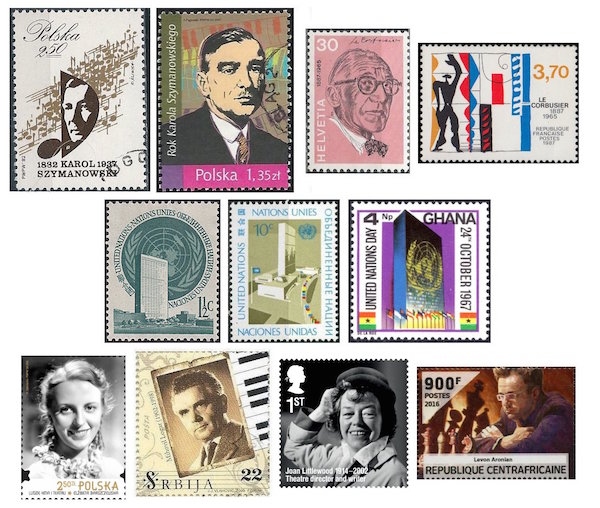The Arts on Stamps of the World — October 6
An Arts Fuse regular feature: the arts on stamps of the world.

By Doug Briscoe
Birthday stamps for October 6 include those for Le Corbusier, Jenny Lind, and Karol Szymanowski, along with seven others with whom I presume you are not likely to be familiar.
Danish-Norwegian poet and playwright Johan Herman Wessel (6 October 1742 – 29 December 1785) wrote satirical and humorous pieces while supporting himself as a tutor. He was the center of a literary circle in Copenhagen, but abused his health with drink and died at the age of 43. His best known stage work is Love without Stockings (Kierlighed uden Strømper, 1772), a parody of heroic classical drama set in mundane 18th-century surroundings. He also wrote one of the earliest pieces about time travel called Anno 7603, though by all accounts it’s a miserable piece of work.
The Polish-Lithuanian painter Franciszek Smuglewicz (smoo-GLAY-vitch, 6 October 1745 – 18 September 1807), also known as Pranciškus Smuglevičius, born in Warsaw, was the son of a painter and of the niece of another. Like many artists, Smuglewicz went to Rome, but in his case he ended up staying there for 21 years. On his return to Warsaw in 1784 he founded a school of fine arts and, not satisfied with that, went to found an Institute of Sketch and Painting at the Vilnius Academy in 1797. He worked for Tsar Paul I in 1801, painting ceilings at the tsar’s new palace, the Mikhailovsky Castle, in St Petersburg. (Paul was assassinated just forty days after moving into his new quarters.) Later Smuglewicz concentrated on historical paintings, like Persian Ambassadors before the King of Ethiopia and Scythian Emissaries Meeting with Darius (both painted after 1785). The stamp shows a fanciful portrait of the infamous Messalina, wife of the Emperor Claudius.

Johanna Maria Lind (6 October 1820 – 2 November 1887), known to posterity as Jenny Lind, the “Swedish Nightingale”, sang on stage from childhood and while still very young became one of the most celebrated sopranos of her day. Both Felix Mendelssohn and Hans Christian Andersen fell in love with her. When Mendelssohn died in 1847 she gave a charity concert the following year to fund a musical scholarship in his name. The first recipient of the Mendelssohn Scholarship was the 14-year-old Arthur Sullivan. Andersen’s infatuation with her likely inspired at least three of his tales (“Beneath the Pillar”, “The Angel”, and “The Nightingale”). P. T. Barnum arranged a very demanding and financially very rewarding tour for her in the United States. Her piano accompanist and conductor for the latter part of the tour was Otto Goldschmidt, whom she married (in Boston!) near the end of the tour. She retired from the operatic stage before she was 30, but continued giving concerts, and was throughout her life a generous philanthropist. Jenny Lind appeared on now-discontinued Swedish currency (the 1996 and 2006 issues of the Swedish 50-krona banknote). Streets are named for her in many towns, three in Massachusetts alone (New Bedford, Taunton, and North Easton)! There’s a Jenny Lind Island in Canada, a Jenny Lind Children’s Hospital and a Jenny Lind Park in Norwich, England, and the town of Jenny Lind, California. At the annual Barnum Festival in Bridgeport, Connecticut, there is a national competition to select a soprano as the Jenny Lind winner. Elvis Costello began to write an opera about her in 2005, but it remains unfinished. She appears on two Swedish stamps, on the later of them alongside Carl Sandburg. (Why the juxtaposition? I don’t know, other than that both were of Swedish descent, but the irony is that I overlooked Sandburg’s birthday way back in January, so apparently philately moves in mysterious ways.)
Next we come to the Swiss novelist and short story writer and Catholic priest Heinrich Federer (6 October 1866 – 29 April 1928). Known to have been gay, he edited the Catholic daily Neue Zürcher Nachrichten from 1899 until he was convicted in 1902 of the sexual abuse of a twelve-year-old pupil in his charge, but it seems the evidence was scanty, and twenty years later the newspaper printed an article declaring his innocence. It seems Federer turned to literature quite late in life, his first novel, Mountains and People (Berge und Menschen, 1911) ushering in a long series of Catholic fiction that became enormously popular in his homeland. Various honors were bestowed upon him, including this stamp from 1966. In the last couple of years of his life he wrote autobiographical volumes, and after his death a book of his poetry was published. (Incidentally, another little known artist with the same name was a German landscape and portrait painter who lived from 1819 to 1859).
Polish composer Karol Szymanowski (6 October 1882 – 29 March 1937) came from a wealthy family of land-owners. He studied at the Warsaw State Conservatory and later became its director. His lameness in one knee kept him out of the horrors of World War I. He, too, was homosexual and even wrote a novel, Efebos, on “Greek love”, but the manuscript was lost during the siege of Warsaw in 1939. (One chapter survives.) He fell ill with tuberculosis and died in a sanatorium in Lausanne. His music can be rather demanding but offers considerable rewards to the persistent listener. I discovered his first Violin Concerto a few years ago and was so fascinated by it that I kept returning to it for months. Simon Rattle made a recording of his compelling Stabat Mater. There are four symphonies, another remarkable violin concerto, two string quartets that have yet to reveal their beauties to me, a lot of piano music, including three sonatas, songs, etc.

One of the principal architects of the last century, Charles-Édouard Jeanneret, known as Le Corbusier (October 6, 1887 – August 27, 1965), left buildings on four continents. Seventeen of these structures have been listed as UNESCO World Heritage sites. Born in the Jura mountains of Switzerland, the youngster was attracted to his father’s work enameling boxes and watches. (Watchmaking was the foremost industry in the town where Le Corbusier was born, and his first formal art instruction was at a school for applied arts, especially as connected with watchmaking.) His painting teacher suggested architecture and, at seventeen, under supervision and with two other students he built his first house, a small villa. In 1908-10 he worked in the office of Auguste Perret in Paris, and after that worked for four months in the office of Peter Behrens, alongside Ludwig Mies van der Rohe and Walter Gropius. Charles settled in Paris in 1917 and began painting at the encouragement of the Cubist Amédée Ozenfant. In the first issue of the new journal L’Esprit Nouveau, Charles-Edouard Jeanneret took on the name Le Corbusier (derived from his maternal grandfather’s name, Lecorbésier). He built no buildings immediately after World War I but focused on theory with the result being his important book Towards an Architecture (1923). Le Corbusier is such a force in architecture that I wonder there aren’t more stamps honoring, if not the man himself, some of his creations. Of course, there are a great many stamps showing the New York Headquarters of the UN (designed by Le Corbusier and Oscar Niemeyer under the direction of Wallace K. Harrison in the years 1947-52), but I know of no others (which doesn’t mean they don’t exist). I show a few examples of the UN building on stamps, including the second United Nations stamp ever issued (in 1951). The portrait stamp comes from his native Switzerland, 1972. Additionally, France issued a stamp of one of Le Corbusier’s paintings, Modulor (1956).
Polish writer Maria Dąbrowska (6 October 1889 – 19 May 1965), after studying sociology, philosophy, and natural sciences in Lausanne and Brussels, settled in Warsaw one hundred years ago. Her concerns were for the common good, addressing poverty and human rights, as manifested in her journalistic work. Her commitment led her to remain in Warsaw during World War II as a supporter of the underground. She wrote plays and novels—the best known being the four-volume historical work Noce i dnie (Nights and Days, 1932-34).
Serbian composer Mihovil Logar (1902 – 13 January 1998) studied in Prague with Josef Suk, but lived most of his life in Belgrade, where he taught at the Music Academy and wrote reviews. In the mid 50s he was president of the Composers’ Association of Serbia. His 200 compositions fall into almost all genres (no sacred music, it appears): four operas, a ballet, cantatas, five works in concerto form, overtures, chamber music, including five string quartets, piano pieces, and songs.
Joan Littlewood (6 October 1914 – 20 September 2002) was an English theater director who has been called “The Mother of Modern Theatre”. Born in London, she was attracted to Communism and, as a consequence, was banned from broadcasting on the BBC from 1941 to 1943. MI5 surveillance of her continued into the 50s. She was one of the founders of the Theatre Workshop (1945) and had great success putting on Mother Courage and Her Children (1955, as both director and actor), Fings Ain’t Wot They Used T’Be (1959) and, perhaps most famously, Oh, What a Lovely War! (1963).
It’s been a while since we’ve had a birthday tribute to a chess player. Today is the 35th birthday of the Armenian Grandmaster Levon Aronian (born 6 October 1982). At twenty he was World Junior Champion. Currently he is the fourth highest rated player (2830) in the history of the game.
A happy birthday, too, to the fine science fiction writer David Brin (born October 6, 1950).
A graduate of the University of Massachusetts with a B.A. in English, Doug Briscoe worked in Boston classical music radio, at WCRB, WGBH, and WBUR, for about 25 years, beginning in 1977. He has the curious distinction of having succeeded Robert J. Lurtsema twice, first as host of WGBH’s weekday morning classical music program in 1993, then as host of the weekend program when Robert J.’s health failed in 2000. Doug also wrote liner notes for several of the late Gunther Schuller’s GM Recordings releases as well as program notes for the Boston Classical Orchestra. For the past few years he’s been posting a Facebook “blog” of classical music on stamps of the world, which has now been expanded to encompass all the arts for The Arts Fuse.
